(en bas de page se trouve un résumé en français)
[ last update: 02.11.2009 ]
The (new) Cadillac Database©
The Cadillac V16
Series 452-452A
1930-1931
Part 3 (e)
The rare bodies by Fisher and the custom creations by
Fleetwood and other coach builders at home and abroad
Return to The (New) Cadillac Database© Index Page
or go back to the V16 index page
![]()
(en bas de page se trouve un résumé en français)
In this section I will describe rare, custom bodies built on the V 16 chassis both by Fisher and Fleetwood, Cadillac's own, in-house coach-builders, as also by independent coach-builders both in the USA and abroad.
Many of these cars have job numbers with the prefix or suffix "X", "LX" or "LS" which identifies then as custom jobs by either Fisher or Fleetwood (apparently both coach builders used the same numbering system for custom jobs). The lowest custom job number I have seen thus far is 2651X, identified by Carl Steig from factory records as a special V16 sedan for five passengers, built along the lines of regular Fisher job #159.
For a time, I was convinced that the initial digits of these "LX" jobs were an indication of the year the special order was recorded; however, taking into account the additional research done by both Carl Steig and Carl Stoutenberg, it seems I may be completely off track. Their research suggests that Fisher and Fleetwood may have built already 2600 custom jobs on the V 8 chassis (and possibly also the La Salle), even before the V16 came on the scene in December of 1929 or the V12 in September the following year.
By late 1933, for example, "LX" cars numbered in excess of 5500 units. Considering that job #2651X was built in 1930 and #5514 in late 1933, this suggests a rate of production of some 1000 custom jobs a year on the three power trains (V8, V12 and V16) and possibly also on the La Salle chassis, although I see none listed in the recently published book by Ron Van Gelderen and Matt Larson on Cadillac's companion car, the La Salle.
I read somewhere that all custom jobs [i.e. those with an "LX" prefix or suffix?] were inspected by Larry Fisher himself, prior to delivery, e.g. style 3159LX, a custom V12 model that Fisher delivered to Don Lee for screen star Joe E. Brown.
Carl Stoutenberg, another V16 aficionado was kind enough to give me his own theory about the origin of these "LX" prefixes and suffixes, based on our combined information about the following seven survivors on the V16 chassis for 1933: #5092LX on chassis/engine #5000024, #5266LX on #5000077, #5270LX on #5000088, #LX5441 on #5000102, #LX5514 on #5000114 [or 5000116?], #LX5528 and #LX5577). Let me share Carl's thoughts with you:
Neil Nicastro's car is #LX5514. I call it the Crandell car as that is who it was originally built for. Crandell was an advertising executive in Chicago not a GM big shot. It was in the Warshawsky collection before Nicastro got it. #LX5528 is the Robert Montgomery car and #LX5577 the Theodore Case car.
The "LX" number is likely nothing to do with Livery and also likely nothing to do with special order V16's [on the latter point, Carl, I still beg to differ]. The reason I say that is a 1933 V16 with a engine #5000028 has an LX number around #LX4471 (I don't have my notes in front of me right now). Neil's is #5000114 with #LX5514. I also know about "LX" numbers on engine/chassis units #5000077 [LX5266?] and #5000106; they are between the numbers I mention above although, again, I don't have them in front of me now.
If "LX" numbers are consecutive which the facts seem to indicate [and I am becoming convinced that this is so] , by interpolation we can deduce there were 1381 "LX" numbers in 1933. But there were only 125 sixteens that year. In fact that number actually is more than the total of all 1933 twelves and sixteens put together [don't forget to include the eights, Carl]. But it is fewer than the total number of Cadillacs built in 1933, so I don't think every car was assigned an "LX" number, while I also don't think only special orders got one [my own theory, Carl, is that all "LX" cars were somehow special order, including V8s; this would account for the high number of them recorded up to 1933, if in fact they were numbered consecutively numbered].
Besides "LX" numbers there is also the "SFBO" number on some build sheets (Special Fleetwood Body Order Number). It refers to the details of the body that made it special. 5000077 with "LX" (I think) #5266, has SFBO #69.
In your database you mention #LX2901 [in 1931]. Possibly the "LX" cars started with that number, but, just maybe, they started with LX0001 and go back to the early 20's. It could be, therefore, that #LX2901 number from '29 or '30 is related [in sequence] to the 1933 "LX" numbers and that they just kept getting larger and larger. I shall now see if I can find a '38 or so "LX" number to test that theory.
Right now it's a mystery that we trivia pursuit lovers are eager to crack.
The "LX" number is found on SOME, but, not all Fleetwood Body tags that go on the cowl of the car. I have not yet found it recorded on any paper documents, which adds to the general mystery.
Sixteens with bodies by Fisher (USA)
There is no recorded reason why thirty-one V16 chassis got regular and custom bodies by Fisher in lieu of the more exclusive Fleetwood styles, many of which were designed exclusively for the great new power plant. In my opinion, Fisher bodies were simply more readily available. Initially, I had believed that all the Fisher bodies were used on early sixteens; in fact, according to further research by Carl Steig of the CLC, close to half of them were built in 1931.
My assumption is that the factory just pulled some regular Fisher styles from the production line and mounted them on the new, sixteen-cylinder chassis fur use as (a) test cars, (b) livery vehicles in and around the Cadillac compound, (c) complimentary vehicles for use by senior GM/Cadillac officials, (d) to make special custom jobs for special clients.
For many years it was believed that of the total number of Fisher-bodied "Sixteens" built (31 in all), none had survived ...and then this one turned up in a private collection in Rhode Island :
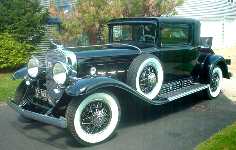
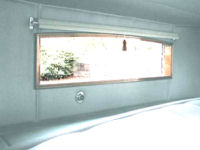
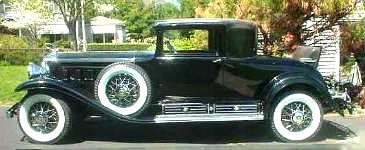
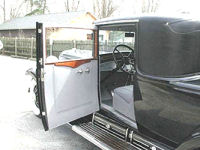
This Fisher style 30-16-158 was owned in 2006 by enthusiast, Bob Perry
[ Photos: Courtesy Dick Shappy ]
The line drawings (montages), below, are made up of parts of other factory designers' drawings by both Fisher and Fleetwood. I am assuming that, with the exception of job #30-X, all the Fisher sixteens used the same hood and lower body as found on early, Pennsylvania-built sixteens, as well as the single-bar bumpers and special V16 tail-lights. Before the above coupe turned up, the only photo available of a Fisher Sixteen was Job #30-X; this was a test car; it used the same hood and lower body as regular Fisher styles for the 1930 Cadillac models.
Update and correction [July, 2008]: I was contacted by Alan who has supplied new, irrefutable evidence about V-16 production numbers for 1930 and 1931. Alan said : it is my understanding from correspondence with Mr. Roy Schneider [Roy wrote the definitive history of the Cadillac V-16 in his authoritative book, "Sixteen Cylinder Motor Cars", Heritage House, © 1974] that Mr. Steig chose #702600 as the cutoff for 1930 V-16 production based upon the fact that 1931 V-8 and V-12 production began in the fall of 1930. I believe that Mr. Steig's choice for the cutoff at that point was reasonable and good judgment based upon the best evidence available at the time; additional information now available supports a different conclusion based upon the following:
As to production numbers for 1930 and 1931, Carl Steig believed that engine number 702600 was the last one to have been built in 1930. Alan Merkel, another keen V-16 enthusiast, had indicated that the last chassis for 1930 was #702883. As I had not examined factory records in person, I had given Carl the benefit of the doubt, based on his in-depth study of vee-sixteen prodution records that he began in the sixties.- Based upon the factory shipping ledger, #702600 was shipped on August 16, 1930, whereas 1931 V-8 shipments began on September 13,1930 and V-12 shipments began on October 15, 1930. Nearly 200 additional V-16s had been shipped in 1930 by the time V-12 shipments began.
- The "model year" concept did not begin until 1936. 1931 V-16s were shipped until the end of 1931 and into February of 1932. Using the August, 1930 cutoff for 1930 V-16s, one would have to believe that 1930 V-16s were produced for 8 ½ months, 1931 models for 18½ months, and then V-16s were produced for 12 months in each of the years from 1932 through 1935.
- The factory shipping ledger shows that #702887 was the highest engine number shipped in 1930. True, two cars with lower engine numbers (702840 and 702883) were not shipped until 1931, but their production would have been in sequential order in 1930.
- The factory shipping log contains a "1931" entry beside #702888 indicating the start of 1931 shipments at that point (I have attached a photo of that entry in the ledger).
- Additional data published at the time we are discussing (1930s) supports the cutoff of 1930 V-16 production at #702887. The BRANHAM AUTOMOBILE REFERENCE BOOK published by the Ben P. Branham Company of Chicago provided detailed data on all passenger cars and trucks showing serial number locations and listings by model year, along with other detailed information useful to insurance companies and agents, state authorities, dealers, law enforcement, and many others in need of accurate data. In the forward to each issue the Publisher acknowledges indebtedness to the auto manufacturers who cooperated by supplying Branham with the information and checking the proofs of the printed matter to ensure reliability of the reference. I have attached photos of the pages from the REFERENCE pertaining to the 1930 and 1931 V-16s showing that 1930 production included engines from 700001 to 702887, and that 1931 production of V-16s included engines starting with 702888 (the last being 703251).
Based upon the above, I hope you will agree that it is not necessary for us to use conjecture as a means of determining the cutoff for 1930 V-16s. Published documents from the period include the information, as supplied by the manufacturer, and provide the answer. I am forwarding the above information to you in hopes that you will reflect it in a future revision to your web site where you refer to 1930 and 1931 V-16s.
Thank you, Alan, for your previous excellent reasearch on the Cadillac V-16 and for taking the time to send me the results of your more recent research into actual production figures for 1930 and 1931. It is my pleasure to share the results of your work with all "Sixteen" fans who visit this site. Below are the images that Alan supplied with his above comments:
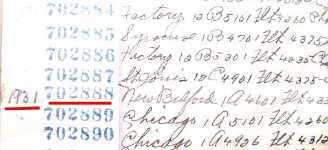
Excerpt from the factory production ledger for V-16 cars;
the manuscript date, "1931" appears opposite engine #702888

Excerpts from Branham Automobile Reference Book; these show the 1930 Series 452 cars as ranging
from #700001 up to #702887 and the 1931 Series 452-A cars as ranging from #702888 up to #703500;
that last figure is certainly a mistake since we know that the final Series 452-A model carried #703251
|
|
|
|
|
Return to The (New)
Cadillac Database© Index Page
or go back to the V16 index page
© 1996, Yann Saunders and the Cadillac-LaSalle
Club, Inc.
[ Background image: Grille badge from the 1930-31 Cadillac V16 models ]